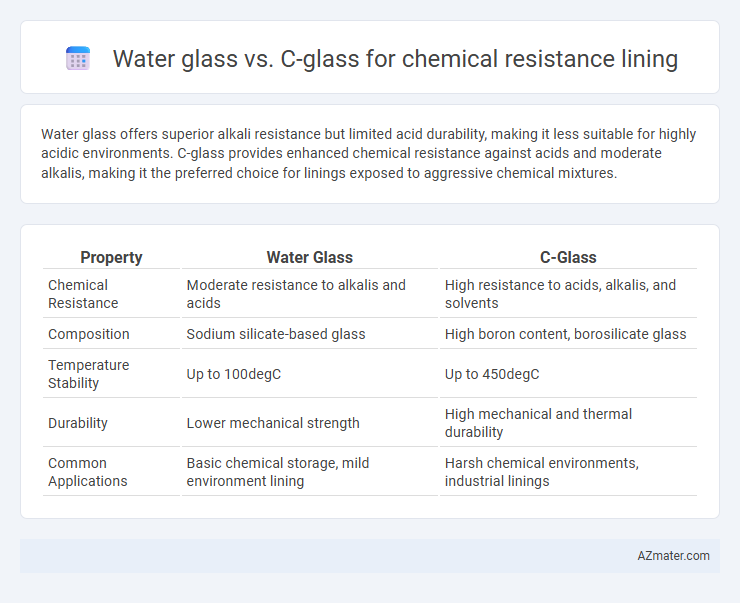Water glass offers superior alkali resistance but limited acid durability, making it less suitable for highly acidic environments. C-glass provides enhanced chemical resistance against acids and moderate alkalis, making it the preferred choice for linings exposed to aggressive chemical mixtures.
Table of Comparison
| Property | Water Glass | C-Glass |
|---|---|---|
| Chemical Resistance | Moderate resistance to alkalis and acids | High resistance to acids, alkalis, and solvents |
| Composition | Sodium silicate-based glass | High boron content, borosilicate glass |
| Temperature Stability | Up to 100degC | Up to 450degC |
| Durability | Lower mechanical strength | High mechanical and thermal durability |
| Common Applications | Basic chemical storage, mild environment lining | Harsh chemical environments, industrial linings |
Introduction to Chemical Resistance Lining
Water glass and C-glass are critical materials used in chemical resistance linings, offering distinct advantages against corrosion and chemical attack. Water glass, a sodium silicate-based material, provides strong resistance to alkaline substances and moderate protection against acids, commonly applied in coatings and sealants for industrial applications. In contrast, C-glass, a type of boron-free glass fiber, exhibits superior resistance to acids and solvents, making it ideal for reinforcing composite linings that require enhanced durability in aggressive chemical environments.
Overview of Water Glass and C-Glass
Water glass, also known as sodium silicate, provides a cost-effective and flexible lining option with good chemical resistance against alkalis and mild acids in industrial applications. C-glass, a chemical-resistant borosilicate glass fiber, offers superior durability and enhanced resistance to acidic and alkaline environments, making it ideal for harsher chemical exposures. Both materials are commonly used in corrosion-resistant linings, but C-glass outperforms water glass in terms of longevity and resistance to aggressive chemical agents.
Chemical Composition Differences
Water glass, primarily composed of sodium silicate (Na2SiO3), offers high alkalinity and moderate chemical resistance, especially against acidic environments. In contrast, C-glass features a borosilicate composition with lower alkali content, enhancing resistance to chemical corrosion from strong alkalis and acids. The distinct chemical compositions define their suitability: sodium silicate-based water glass excels in acid-neutralizing linings, while borosilicate C-glass provides superior durability in highly corrosive chemical environments.
Resistance to Acids and Alkalis
Water glass linings exhibit excellent resistance to alkalis due to their high sodium silicate content, making them ideal for alkaline chemical environments. C-glass linings offer superior resistance to acids, especially hydrofluoric and sulfuric acids, due to their borosilicate composition that enhances acid durability. Selecting between water glass and C-glass depends on the specific chemical exposure, prioritizing alkali resistance with water glass and acid resistance with C-glass for optimal chemical lining performance.
Performance in High Temperature Environments
Water glass linings exhibit moderate chemical resistance but degrade at temperatures above 150degC, limiting their use in high-temperature chemical processing. C-glass linings, composed primarily of alumino-borosilicate fibers, maintain superior structural integrity and chemical resistance at temperatures up to 400degC, making them ideal for harsh, high-temperature environments. The enhanced thermal stability and resistance to alkali attack in C-glass significantly outperform the silica-based water glass under prolonged exposure to aggressive chemicals and heat.
Long-Term Durability and Lifespan
Water glass and C-glass both serve as effective chemical resistance linings, but C-glass offers superior long-term durability due to its enhanced alkali resistance and structural stability in harsh environments. Water glass, primarily sodium silicate, can degrade faster under acidic or high-temperature conditions, resulting in a shorter lifespan compared to the more chemically resistant borosilicate composition of C-glass. For applications requiring extended service life in aggressive chemical settings, C-glass lining is the preferred choice, ensuring better performance and reduced maintenance costs over time.
Application Methods and Compatibility
Water glass linings, primarily sodium silicate-based, are often applied through spray or trowel methods, providing excellent corrosion resistance in alkaline environments but limited acid resistance, making them suitable for moderate chemical exposure. C-glass linings, composed of alumino-borosilicate glass fibers, are typically used in resin or epoxy matrices with lamination or spray-up applications, offering superior chemical resistance against acids and aggressive solvents. Compatibility considerations favor water glass for boiler or heat exchanger linings where thermal stability and alkali durability are prioritized, while C-glass is preferred for chemical storage tanks and piping exposed to strong acidic or solvent-based chemicals.
Cost and Availability Comparison
Water glass linings offer a cost-effective solution with moderate chemical resistance and are widely available due to simpler manufacturing processes. C-glass provides superior chemical resistance and durability but comes at a higher price point and may have limited availability depending on regional suppliers. Choosing between water glass and C-glass depends on balancing budget constraints with the required performance and local supply options.
Environmental and Safety Considerations
Water glass linings, composed mainly of sodium silicate, offer excellent chemical resistance against alkalis and mild acids but may release hazardous alkaline substances upon degradation, requiring careful handling and disposal. C-glass linings, rich in boron oxide, provide superior resistance to acids and aggressive chemicals with lower leaching risks, enhancing environmental safety during use and after service life. Choosing C-glass over water glass improves overall chemical containment, reduces environmental contamination potential, and complies better with safety regulations for hazardous chemical applications.
Choosing the Right Glass for Specific Industries
Water glass offers moderate chemical resistance suitable for industries handling mild alkalis and silicates, making it ideal for detergents and agriculture. C-glass provides superior resistance against chemical corrosion, particularly from acids and alkalis, making it the preferred choice in chemical processing and fiberglass manufacturing. Selecting between water glass and C-glass depends on the specific chemical exposure and durability requirements of the industry application.

Infographic: Water glass vs C-glass for Chemical resistance lining
 azmater.com
azmater.com